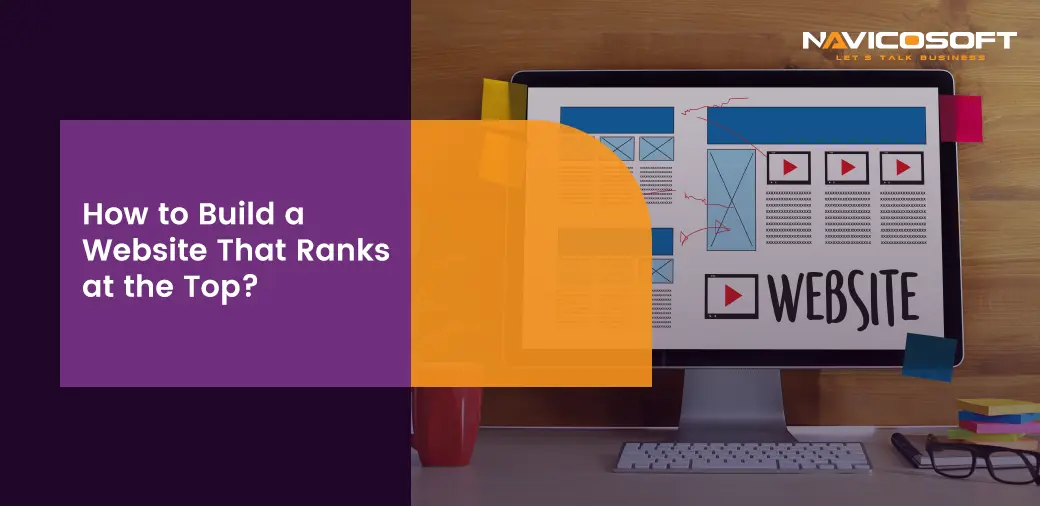Hosting services with real-time fast performance?

How to Build a Website That Ranks at the Top?
In the age of the internet, it is crucial to establish an effective online presence. The best way to achieve this is to build a website that ranks at the top in search engine results. However, creating such a website is not easy. Additionally, it requires careful planning, strategic decisions, and consistent efforts. In this blog post, let’s explore the step-by-step process of creating a website that ranks at the top.
Understanding SEO
Before diving into the website-building process, it’s essential to understand the foundation of a high-ranking website—Search Engine Optimization (SEO). Basically, SEO refers to optimizing a website to rank higher in search engine results. This involves making your site more visible, relevant, and attractive to search engine algorithms. To create a website that ranks, you need to master SEO fundamentals and keep up with its changing trends.
Here’s how SEO works. Search engines use bots to check out your site and decide its rank. They look at your content quality, site navigation, and the number of other quality sites linking to yours.
To do SEO well, focus on the following:
- Quality Content: Provide helpful information with natural keyword use.
- Site Architecture: Make your website easy to navigate and mobile-friendly.
- Inbound Links: Get high-quality websites to link to your site to boost your ranking.
Remember, SEO changes as search engine rules evolve. It’s all about making a user-friendly website that search engines love.
A Deeper Look at SEO and Web Design’s Collaboration
Let’s dive deep into web design and SEO and how these two seemingly different areas combine to build a website that ranks.
Web Design’s Role in SEO
Web design contributes a vital role in your SEO strategy. However, a website that’s designed well can make visitors stick around longer. The longer they stay, the more search engines consider your website valuable. Moreover, it can boost the website’s ranking as well.
Make your websites navigable for visitors.
Imagine your website as a digital city. If it’s challenging to find what you’re looking for or know where you’re going, you wouldn’t want to stay in that city for long. This principle holds for your website as well. A design that makes it easy for visitors to find the information they’re looking for can make a big difference in how long they stay on your site.
Moreover, this ease of navigation isn’t just important for your human visitors and search engine bots that crawl your site to understand what it’s about. Additionally, these bots can easily crawl and understand your site. It enhances the chances of your website ranking higher on search engines.
Make your Websites mobile-friendly
With the rise of smartphones, many people now browse the web on their phones rather than their computers. Because of this, your website needs to be designed to work well on a smaller screen. Visitors might leave quickly if your site doesn’t work well on mobile devices. Moreover, it can negatively affect your site’s SEO. Furthermore, all search engines like Google have started prioritizing mobile-friendly websites in their rankings. It highlights the importance of a mobile-friendly design to build a website that ranks.
Website Speed is Essential
Speed is another critical factor in both web design and SEO. Visitors may become impatient with slow-loading websites and may leave your site before it has finished loading. If this happens, search engines assume your site could be more valuable and relevant, harming your ranking. Elements of your website’s design, for instance, the size of your images and the number of plugins you use, can influence how quickly your site loads. Moreover, these elements must be optimized to maintain a fast website during the design process.
The Influence of SEO on Web Design
On the other side, SEO can significantly influence your website’s design. The insights gained from SEO can help you create a design that meets your audience’s needs and appeals to them.
Keywords Guide Your Design
Keywords are at the heart of SEO. People use these words or phrases to search for information online. Knowing what keywords are relevant to your website can guide the design process. Additionally, it makes us understand what content our audience finds valuable. You can then design your site to make this content easy to find and consume.
First Impressions Matter
SEO isn’t just about the content on your website. It’s also about how your website is presented to potential visitors. The meta descriptions and title tags that appear in search engine results are often the first interaction someone has with your website. Therefore, you should write intriguing and valuable descriptions. In this way, you may get more people to click on your site, boosting traffic and ranking.
Clean URLs Make a Difference
SEO also encourages the use of clean, easy-to-read URLs. Your website’s URLs should be as straightforward as possible. In addition, it helps users and search engines understand the purpose of each page. This simplicity can improve the user experience and the effectiveness of your SEO.
Alt Text for Images
When you add images to your site, SEO best practices suggest adding an alt text to each image. This text briefly describes the image. This can help people who can’t see the image understand what it’s about. It also provides search engines with additional information about your site’s content. This small step can go a long way in making your website more accessible and improving your SEO.
SEO and web design are closely linked and work together to build a website that ranks. An easy-to-use, attractive website with high-quality content can attract and retain users precisely. So when creating a website, consider SEO and web design partners in your project, not separate entities. Create a website that engages your target market and ranks highly in search engine results.
Guided Steps for Crafting a High-Ranking Website
Planning Your Website
Think of planning your website as charting a map for your online presence. This step lays the groundwork for everything that follows. During this phase, you’ll define your website’s purpose, identify your target audience, and outline the site’s structure. Moreover, precise planning is pivotal when you aim to develop a website. It ensures that every page and every piece of content has a defined purpose. It serves your broader business goals and audience needs.
Choosing the Right Domain Name
Your domain name is exactly like your address on the web. It should be easily memorable, simple to type, and give an idea of what your website is about. Therefore, you should pick a relevant and concise domain name. The crucial step is to build a website that ranks. It’s your website’s first impression, and a well-chosen domain name can positively impact your website’s visibility.
Selecting a Web Hosting Service
A web host offers the tools and services required to view your website online. When selecting a web hosting service, consider reliability, speed, customer service, and security features. Additionally, the hosting service’s performance directly affects your website’s accessibility and functionality. It can affect the search engine rankings.
Designing the Website
Designing your website involves creating an aesthetic and user-friendly interface. Therefore, you should select a clean layout, intuitive navigation, and a color scheme. This should align with your brand image and enhances user experience. Remember, a user-friendly design isn’t just about looks. It’s about functionality too. This balance of form and function in design is a significant factor in building a website.
Content Creation
The content of your website is what provides value to your visitors. It should be well-written, informative, and engaging. Therefore, you should incorporate relevant keywords in a natural and meaningful way. So, your content will attract the right audience and increase your visibility on search engines. Regularly updating your site with fresh content encourages return visits. It helps in positioning your site as a reliable source of information. Also, it assists you in building a website that ranks on the SERP.
On-Page SEO
On-page SEO involves optimizing each webpage to improve its visibility in search engine results. Elements like title tags, meta descriptions, headers, URL structure, and keyword usage in the content all come into play. Moreover, each optimized page increases the likelihood that search engines will index your site correctly, boosting its overall visibility.
Off-Page SEO
Off-page SEO refers to actions outside your website to enhance credibility and visibility. Additionally, it primarily involves building backlinks from other reputable websites. It signals to the search engines that your site is a trusted authority. When other websites link to yours, it enhances your website’s perceived value, which helps to build a website that ranks.
Mobile Optimization
With the proliferation of mobile devices, the website must function well on smaller screens. Moreover, mobile optimization ensures your site’s design is working effectively on all devices. For ranking and indexing purposes, Google uses mobile-first indexing, meaning mobile optimization is essential for websites that want to rank highly.
Website Speed
Speed is a make-or-break factor for websites. Visitors may leave if your site takes too long to load, and you might need to catch up in search engine rankings. Moreover, you should improve the website speed, which includes optimizing images, leveraging browser caching, and reducing server response time. Fast, responsive websites have a higher chance of ranking well.
Secure Sockets Layer (SSL)
A security standard called SSL creates secure connections between web servers and browsers. It ensures that all data passed between them remains private. Moreover, SSL protects your users’ data and positively influences your ranking. Google confirmed that it considers SSL as a ranking factor, so it’s essential for anyone looking to build a website that ranks.
Analytics and Reporting
You can track your website’s functionality and user behavior using analytics tools. Tools like Google Analytics can provide helpful information about your site’s traffic sources, the most popular pages, and visitor behavior. Moreover, this data can guide your efforts to improve your website and help you understand how your changes affect your ranking over time.
Regular Updates
Maintaining a website is an ongoing process. Regular updates to your site, including new content, updated information, design tweaks, and SEO improvements, keep your website relevant and competitive. Regularly updated sites are seen as more reliable and current by search engines, helping you to build a website.
Building a website that easily ranks high in search results is a marathon rather than a sprint. Additionally, it requires continuous efforts, strategic planning, and the flexibility to adapt as search engine algorithms evolve.
Making a website that lands at the top of search results takes work. It needs hard work, time, and some know-how. Moreover, you need to give your visitors helpful stuff and make search engines see you as trustworthy. If you follow the steps in this guide, you’re on the right path to building a website that ranks high and stands out online.
A Simple Guide to Getting Your Site Noticed on Google Maps
Optimizing your website for Google Maps is an often overlooked aspect when you’re on a mission to build a website that ranks. Here’s why it’s essential and how you can do it.
The Importance of Google Maps Optimization
Why should you bother optimizing for Google Maps? Simply put, it’s a significant player in local search. When people look for services “near me,” Google Maps is usually the first port of call. Having your website appear on Google Maps can increase visibility, especially for local businesses. Now, let’s discuss how to optimize your site for Google Maps.
Step 1: Create and Verify Your Google My Business Account
First, you must set up a Google My Business (GMB) account. You can manage your digital presence on all Google properties, including Search and Maps, with GMB, a free tool. Additionally, you should verify and update the information about your company. This can make it easier for clients to find you and share your story.
Step 2: Provide Complete and Accurate Information
Make sure to provide comprehensive and correct information about your business. It includes your physical address, phone number, business hours, and business category. You should also include a brief yet accurate description of what your business does. It aids Google in comprehending your company and may boost your position in local search results.
Step 3: Ask for Reviews
Reviews can significantly impact how you rank in Google Maps. Encourage happy customers to leave reviews. Respond to reviews promptly and professionally. Moreover, this interaction influences your ranking and shows potential customers you value their feedback.
Step 4: Use Local Keywords
If you want to build a website that ranks, consider the language of your audience. Are there specific terms or phrases that locals use to refer to your location? Do your research and use local keywords in your website and GMB description.
Step 5: Optimize Your Website for Mobile
Most Google Maps searches occur on mobile devices. Make sure your website is mobile-friendly. A mobile-optimized site can lead to a better user experience, a positive signal for both Google Maps and organic rankings.
Step 6: Embed Google Maps on Your Website
If you want to boost your Google Maps ranking, consider embedding a Google Map on your website. It’s a great way to tell Google that your business is located where your listing says it is. However, you can easily add a map displaying your company’s location to your website with a few clicks.
Step 7: Regularly Update Photos in Your GMB Profile
Adding photos to your GMB profile isn’t just about making it look nice (although that’s also important). Photos can impact how Google ranks businesses in Google Maps. Regularly update photos of your business, products, or services to keep your profile fresh and engaging.
Step 8: Build Local Links
SEO continues to depend heavily on link creation. However, you want to focus on building local links for Google Maps. Contact local bloggers, news outlets, or businesses to see if they want to link to your website. These local relationships can strengthen your reputation and raise your likelihood of showing up higher on Google Maps.
These methods will help you optimize your website for Google Maps and increase the likelihood that local clients will find your company. Remember, it’s not just about being visible but also about providing complete and accurate information to make potential customers choose your business over others. As they say, the devil is in the details. Pay attention to them, and you’ll be on your way to building a website that ranks.
Optimizing Your Site for Yahoo Search Engine Rankings
When aiming to build a website that ranks, it’s crucial to consider all your search engine bases, not just Google. Today, let’s shed some light on how you can enhance your site for Yahoo.
Getting Acquainted with Yahoo’s Preferences
Yahoo uses its search algorithm to rank websites, just like Google. However, the factors that Yahoo considers necessary differ from Google’s priorities. Recognizing these variations will enable you to adjust your strategy to Yahoo’s viewpoint.
Content Matters
Like any other search engine, Yahoo greatly values high-quality, unique content. This content should be original, well-written, and offer value to your audience. Moreover, you should add new content to your website helps keep visitors interested while also letting search engines like Yahoo know that it is a credible and dynamic website.
Use Relevant Keywords
Keywords remain a cornerstone of SEO, no matter the search engine. Conducting in-depth keyword research helps identify the most relevant terms to your website and your audience, which is critical. Once you’ve identified these keywords, use them naturally throughout your site’s content. But, as always, remember that keyword stuffing can harm, not help, your SEO efforts.
Meta Tags Are Your Friends
While Google has moved away from using meta keywords as a ranking factor, Yahoo still considers them. It’s worth adding relevant meta keywords to your pages. In addition, remember title tags and meta descriptions. These are important for all search engines, including Yahoo.
Backlinks Hold Value
Yahoo, like Google, values backlinks, especially from reputable sources. Building a network of high-quality backlinks can indeed help improve your site’s credibility and rank on Yahoo. It’s essential to focus on backlinks’ quality rather than quantity. Moreover, it aims for links from respected websites in your industry.
Optimize for Mobile
As more people are using their mobile devices to browse the internet, ensuring mobile-friendliness is more important than ever. A website that isn’t mobile-friendly could not perform as well in Yahoo’s search engine rankings.
Stay Active on Social Media
While it’s debatable whether social media activity directly influences SEO rankings, there’s no denying that an active social media presence can boost your online visibility. Sharing your content on social media (all forms) can drive more traffic to your site, indirectly improving your Yahoo ranking.
Ensure Your Site Loads Quickly
User experience depends heavily on page loading speed, affecting your search engine rankings like Yahoo. Moreover, you should optimize your images, leverage browser caching, minimize redirects, and consider using a Content Delivery Network (CDN) to enhance your site speed.
Make Use of Yahoo’s Webmaster Tools
Yahoo offers a range of webmaster tools that can help you understand how Yahoo views your site. Use these tools to find potential problems, submit your sitemap, and keep track of your site’s Yahoo performance.
Remember that the objective is to build a website that ranks highly on all major search engines, not just one. This broad-spectrum approach can ensure maximum visibility for your site, helping you reach your target audience effectively. So, while Google is undoubtedly a significant player in the search engine world, take notice of the incredible benefits of optimizing your site for Yahoo’s search engine rankings.
Getting the Most Out of Google AdWords Keyword Planner for Your Website
The Google AdWords Keyword Planner can be a priceless resource when building a website that ranks. Here’s a comprehensive, easy-to-understand guide on optimizing your site using this tool.
Step 1: Understand What Google AdWords Keyword Planner Is
Google AdWords Keyword Planner is a freebie tool provided by Google to assist in keyword research. It helps you discover new keyword ideas, see how keywords perform, and create a new keyword list by multiplying several keyword lists together.
Step 2: Setting Up Your Account
First, set up a Google Ads account to use the Keyword Planner. It’s a simple process where you provide your email and website URL. Once you have an account, you can access the Keyword Planner under the “Planning” section.
Step 3: Discovering New Keywords
The Keyword Planner lets you discover new keyword ideas based on terms relevant to your products or services, landing page, and product categories. Enter these details, and the tool will give you a list of suggested keywords and information about their search volume and competition.
Step 4: Using Keyword Filters
With the large volume of keyword suggestions, you should narrow your list. You can do this by setting up keyword filters. These include competition level (low, medium, high), average monthly searches, top-of-page bids (low range and high range), and keyword text.
Step 5: Understand Keyword Metrics
Understanding the metrics the Keyword Planner provides to build a website that ranks is essential. These include:
– Avg. Monthly Searches
The average number of searches for a particular keyword over the past 12 months.
– Competition:
How competitive ad placement is for a keyword. High competition means many advertisers are bidding on this keyword.
– Top-of-Page Bid (Low Range and High Range):
The minimum and upper bounds of what marketers typically pay for a keyword’s top-of-page bid.
Step 6: Selecting the Right Keywords
Choosing the right keywords involves a balance between search volume and competition. While it’s tempting to go for high-volume keywords, they often come with high competition, making it harder to rank for them. Low-competition keywords, meanwhile, may have lower search volumes but are simpler to rank for.
Step 7: Incorporating Keywords into Your Website
Once you’ve selected your keywords, it’s time to incorporate them into your website. This could be in your website’s content, meta descriptions, and title tags. Remember, it’s essential to use keywords naturally and avoid keyword stuffing.
Step 8: Keeping Track of Performance
Finally, remember that SEO isn’t a set-and-forget strategy. Keep track of your keywords’ performance and adjust your strategy as necessary. The Keyword Planner tool allows you to track your keywords’ performance offering you helpful information on the results of your SEO efforts over time.
You can employ the Google AdWords Keyword Planner to enhance your site’s SEO efforts. As a result, build a website that ranks higher on search engine results.
The Amazing Potential of Content Repurposing for Various Channels
Building a website that ranks requires many techniques, including effective content repurposing. This practice can extend your content’s reach, engage different audiences, and reinforce key messages. So let’s delve into how you can make the most out of your content by repurposing it for different channels.
Why Content Repurposing Matters
Content repurposing is adapting and recycling your existing content to suit different formats or channels. Not only does it save you time and resources, but it also amplifies your brand message and widens your content’s visibility.
Starting with High-Quality Core Content
Before you can repurpose content, you need high-quality core content. Whether it’s a blog post, a video, or an in-depth report, ensure your audience finds valuable content. The high-quality core content is easier to repurpose and can yield more engaging derivative pieces.
Turning Blog Posts into Infographics
One common way to repurpose content is by converting blog posts into infographics. Infographics are visually appealing and easily digestible, making them ideal for sharing on visual platforms like Pinterest or Instagram. By turning critical points from your blog post into an infographic, you allow your audience to consume the same information in a quicker, more engaging manner.
Transforming Videos into Podcasts
If you’ve created video content, consider extracting the audio to create a podcast episode. Podcasts are an increasingly popular medium, especially for audiences who prefer audio content they can consume while multitasking.
Creating Social Media Snippets from Long-form Content
Long-form content like e-books or white papers can be repurposed into bite-sized snippets for social media. Each point or idea from your long-form content could be a standalone social media post, effectively creating a series of posts from one piece of content.
From Webinars to Blog Posts
If you’ve hosted a webinar, you can transform it into several blog posts. In addition, break down your webinar into smaller segments. Also, you can create a blog post for each segment. This approach repurposes your content and makes it more digestible for your audience.
Converting Customer Testimonials into Case Studies
Positive customer testimonials can be developed into detailed case studies. Case studies provide evidence of your brand’s competence and value and can be featured on your website, shared on social media, or used in newsletters.
Stay Consistent and True to Your Brand
Staying consistent with your brand’s voice and message is crucial regardless of how you repurpose your content. Every content should align with your brand’s identity and values, even when adjusted for different platforms.
Measure Success and Adjust Accordingly
Lastly, always measure your content’s performance across different channels. Use analytic tools to track engagement, reach, and conversion. With this information, you can adjust your strategy, focusing more on channels where your repurposed content performs best.
Remember, to build a website that ranks, your content needs to be high-quality, consistent, and tailored to the platforms you use. Moreover, you should repurpose your content wisely; you can boost your website’s visibility and make the most of every piece of content you create.
Final Thoughts: Simple Steps Towards a High-Ranking Website
In conclusion, we’ve walked through the steps to build a website with a high-ranking potential. Be it laying out your plans, picking the correct name, finding the best place to host your site, designing, crafting content, and understanding SEO. Moreover, the role of mobile-friendly design, website speed, and safety were not overlooked, as these are key in creating a user-friendly site.
We’ve also dived into how SEO and web design work together and the process of optimizing your website for different search engines and tools, like Google Maps and Google AdWords Keyword Planner.
Lastly, we discussed stretching your content’s reach by reusing it on different platforms. It’s about more than just the look of your website; what matters is providing worthwhile content and earning the trust of search engines.
Wrapping up, remember that building a website that ranks takes time, consistency, and value. It’s a continuous job that needs your commitment. However, with this effort, you can see your website move up in search results, reach more people, and stand out online. Keep learning and improving, and you’re on the right path.













